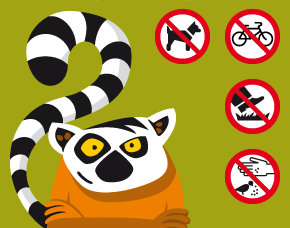březen–říjen: 8.00–19.00 (pokladna do 18:00)
listopad–únor: 9.00–17.00 (pokl. do 16:30)
Otevřeno 365 dní v roce včetně svátků, Vánoc a Nového roku! (DinoPark otevřen pouze od dubna do října). Více zde.
Najdete nás zde.
Talarak, the Kingdom of venom, the species in the tropical pavilion and some from other parts of the Zoo don’t belong to any of the six realms. It’s usually because of the origin stories of each and every pavilion. Some species therefore do not yet live in their respective realms – chimpanzees, Aldabra giant tortoise and some species from the Philippines.
Tropical Pavilion
The building in the shape of the letter Z is rightfully named the Tropical pavilion. It shelters great riches in the form of mostly tropical plants and animals. The newest exhibit Philippines was opened late in the year 2018 and is right next to the Talarak exhibit.
The Philippines exhibit is unique mostly for keeping the endemic Philippine crocodile (Crocodylus mindorensis). This species is critically endangered in nature, where their numbers have dropped down to 500. To date there are 2 females originally from the Protivín Crocodile Zoo. Another rare species is the yellow-headed water monitor (Varanus c. cumingi), mangrove snake (Boiga dendrophila), the endangered Philippine sailfin lizard (Hydrosaurus pustulatus) and extremely rare turtles – the Asian leaf turtle (Cyclemys dentata) and spiny turtle (Heosemys spinosa). The exhibit is enriched by the addition of tarantulas, walking sticks, stag beetles, rhinoceros beetles and Asian tropical butterflies. The visitors can witness a pristine transformation, when a full-grown butterfly emerges from the suspended chrysalis. Hence, they are let out to fly free in the exhibit.
Kingdom of venom
This mysteriously named exhibit showcases not only the most poisonous snakes in the world, but also shows many other poisonous animals and plants and their significance. Even the Renaissance physician and astronomer Paracelsus once said that the only difference between a remedy and poison is in the dosage! The visitors can, however, be at ease, for everything is absolutely bite-proof. The habitats of the terrariums show us the natural environments of the individual species.
The second part of the tropical pavilion is designed for breeding the endangered and the largest tortoises in the world, the Aldabra giant tortoise (Dipsochelys dussumieri). They share their home with a group of ring-tailed lemurs (Lemur catta) kept for breeding. Spacious terrariums are inhabited by the Mertens' water monitors (Varanus mertensi), while the reticulated pythons (Broghammerus reticulatus) can grow into staggering sizes.
Our closest relatives, the chimpanzees (Pan troglodytes) have a huge glass bedroom along with a heated floor including interactive features at their full disposal, along with another bedroom in the breeding areas, a large outdoor enclosure featuring an interactive termite mound. They can also have fun at their spacy playground offering them a relief from boredom and shelter at times of unkind weather. A whole group can be observed here.
A Window into the Private Life of Plants
The botanical exhibit was created in 2017 in front of the Afro-asian pavilion. It is unique mostly for its graphic depiction of the phenomena happening in the world of plants, their intimate life. It mostly touches on 3 subjects, namely pollination, dispersal and nutrition of plants. We heartily recommend it for illustrative education of botany.
A path with illustrative information panels going through the exhibit explain these phenomena in an elegant and simple manner. The therein discussed species grow next to every information panel. For example, next to the information panel about sexual reproduction grows the greater burdocks (Arctium lappa), which has hooks on its seeds. The seeds latch onto various objects and can be transmitted by human clothes, fur of wild hogs or even your dog, when he runs through a meadow.
Invasive species like the giant hogweed (Heracleum mantegazzianum) are grown in a special fenced area, while non-native species are in front of it. They are predominantly useful, which have come along with humans for centuries.
In the center of Pilsen there is a separate exhibition Akva Tera. Small guide is here:


Zoologická a botanická zahrada (Zoo):
Zoo + DinoPark (pouze duben–říjen):
Podrobné vstupné a slevy zde.
